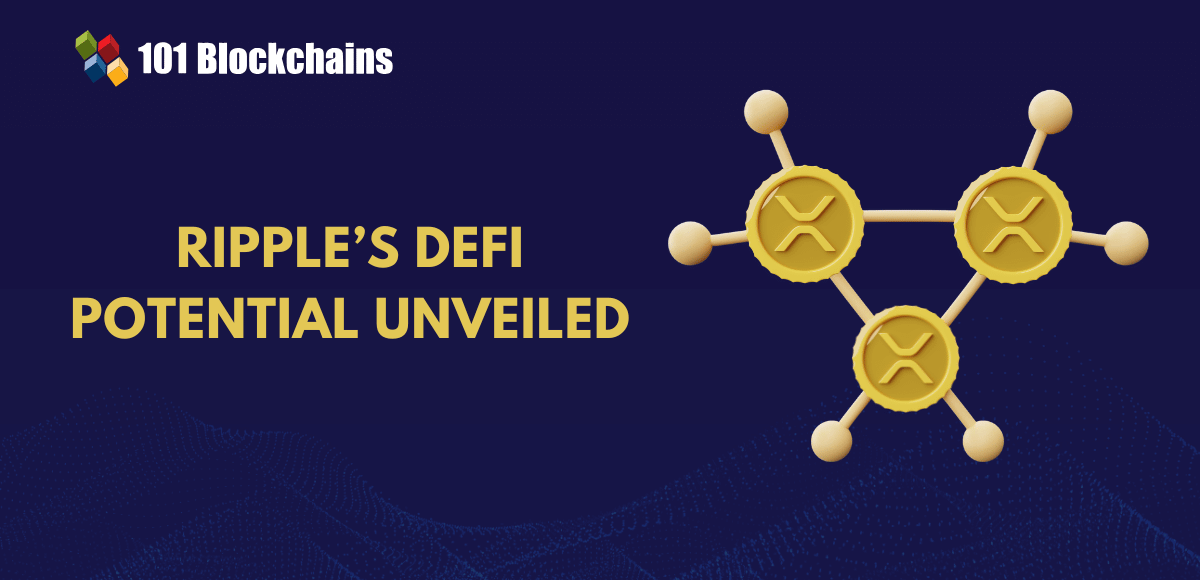Learn how blockchain truly works, master key definitions, and uncover what makes smart contracts so "smart." Dive into the fundamentals, gain valuable insights, and start your blockchain journey today!

- Decentralized Finance
Gwyneth Iredale
- on July 14, 2021
Pros and Cons of Decentralized Finance (DeFi)
Decentralized finance has a profound influence on the way banks operate and introduce shifts in the general financial ecosystem. At present, there are many contradictory views regarding decentralized finance for the right reasons. Some perceive DeFi as a revolution, while others think of it as an opportunity, and then there are people who find it as a scam.
Therefore, a neutral impression of the world of DeFi could provide a clear idea of their role in the overall financial system. Let us find out more about the pros and cons of decentralized finance in the following discussion. With a comprehensive view of the pros and cons related to DeFi, readers could identify the true potential of DeFi.
Want to become an enterprise DeFi expert. Enroll Now: Decentralized Finance Course
Understanding DeFi
Before starting with the discussion on DeFi pros and cons, it is important to understand DeFi briefly. The financial services domain has been responsible for encouraging many of the notable use cases pertaining to blockchain technology. Blockchain presents vital opportunities for transforming conventional finance through online payments and virtual assets storage and trading. With the rise of DeFi, the applications of blockchain in finance have started to gain significance.
The term DeFi actually points out an acronym for decentralized finance. It basically refers to the assortment of blockchain-based applications offering peer-to-peer alternatives for conventional financial services and institutions. The recognition of DeFi has been growing profoundly in recent times, as a result of which it has been drawing in substantial volumes of capital. So, what exactly should drive you to find out the advantages and disadvantages of decentralized finance?
To know more about decentralized finance, check this detailed video now
Why Focus on the Pros and Cons of Decentralized Finance (DeFi)?
The market demand for DeFi is becoming more prominent with each passing day. According to estimates by DeFi Pulse, a renowned data aggregator meant for decentralized finance, the total value in DeFi protocols presently amounts to almost $11.5 billion. Just a year ago, the total value locked in DeFi protocols was just around $1 billion, thereby exhibiting promising growth.
Even if the monetary value associated with DeFi does not match up to conventional financial markets, DeFi has grown profoundly. In just a matter of one year, DeFi has been able to score mind-boggling popularity. The faster growth rate also reflects profoundly on the strength associated with the value proposition in DeFi.
Learn the fundamentals of Decentralized Finance (DeFi) with DeFi Flashcards
Pros of DeFi
The promising aspects related to DeFi discussions point out to effective observation of the advantages and disadvantages of DeFi. The DeFi movement aims at introducing various benefits for customers and investors. Some of the notable advantages of DeFi would include the elimination of intermediaries alongside centralized control.
In addition, it would aim at improving the accessibility of financial markets to institutional investors. At the same time, DeFi would also work on the creation of new investment opportunities that can take the concept to new levels. In order to achieve the benefits, DeFi solutions rely largely on the fundamental traits associated with blockchain technology.
1. Permissionless
The first and foremost factor which defines the identity of decentralized finance is the term ‘decentralized.’ The pros and cons of decentralized finance rely largely on the defining nature of the concept. Decentralization is one of the basic tenets of blockchain, and it helps in reducing the need to depend on corporations.
Furthermore, decentralized finance also takes away the pressure of depending on institutions for oversight, data storage, server space, and other factors. Blockchain networks are successful in achieving all these aspects by ensuring that specific transaction histories can be easily circulated throughout all members.
The decentralization approach is quite helpful for democratization of banking and finance. DeFi could ensure simple and effective access to financial services for every individual. DeFi pros and cons discussions would also show that majority of DeFi solutions run on Ethereum. Ethereum is the second-largest blockchain protocol, and its permissionless nature ensures that it is highly decentralized in nature.
Furthermore, it should be readily accessible to any individual associated with development and use of DeFi applications. The permissionless nature of blockchain in DeFi applications could also get the support of interoperability from blockchain. As a result, it can ensure flexible options for ensuring different types of third-party integrations.
At the same time, it is also crucial to observe how the permissionless blockchain features are not specific to Ethereum. Since Ethereum is a preferred network for developing smart contracts, it is a reliable choice for building DeFi applications.
Build your identity as a certified blockchain expert with 101 Blockchains’ Blockchain Certifications designed to provide enhanced career prospects.
2. Immutability
The effective utilization of cryptography along with consensus algorithms such as proof-of-work has helped blockchain in achieving actual immutability. So, the advantages and disadvantages of decentralized finance have enabled the true benefits of immutability in finance.
With the help of immutability, it is practically impossible to manipulate any record on the blockchain network. In addition to the features of decentralization, immutability offers the promising assurance of security. Interestingly, the blockchain functionalities for immutability ensure the integrity of DeFi solutions in carrying out financial transactions.
3. Transparency
While immutability is an essential requirement for the DeFi landscape to provide assurance of security, transparency is also one of the notable additions among DeFi pros. Decentralization obviously entails better transparency, and the distributed ledger features information about all activities on the blockchain network.
The cryptographic principles for blockchain also ensure the documentation of information only after verification of authenticity. The advantages and disadvantages of DeFi showcase how customers could benefit from the transparency of DeFi applications.
For example, transparency in DeFi applications could improve due diligence. At the same time, DeFi applications could also support people in identifying and avoiding possible financial scams as well as negative business practices. With a proper audit trail, DeFi applications could make it easier to identify who made changes to a transaction, at what point of time, and in which way. As a result, there would be little left to compromise the integrity of financial ecosystems.
Start learning Blockchain with World’s first Blockchain Skill Paths with quality resources tailored by industry experts Now!
4. Lending and Borrowing Applications
DeFi has also been a significant player in fostering the development of peer-to-peer lending and borrowing solutions. Such types of lending and borrowing solutions offer substantially promising benefits for end-users. The pros and cons of decentralized finance would obviously reflect on cryptographic verification mechanisms.
At the same time, they also provide the assurance of smart contract integration. The facility of such functionalities ensures the elimination of intermediaries like banks which are generally responsible for the verification of parties in a transaction. In addition, it also works for verification of the process associated with lending and borrowing transactions.
As a result, DeFi enables a faster and easier verification process in lending and borrowing applications. Simultaneously, DeFi also ensures safeguards for counterparties in a transaction. DeFi applications in lending and borrowing would also facilitate the benefits of faster transaction settlement with better accessibility.
Presently, lending and borrowing applications account for the most renowned DeFi applications. One of the most notable examples showcasing DeFi pros and cons, albeit with a focus on the pros, is Compound. It is a decentralized lending platform that allows lenders to supply crypto assets to a specific number of lending pools.
The lending pools feature available for other people to borrow, and lenders would receive a share of the interest paid back by borrowers to the pool. The interest rate earned by a lender relies profoundly on the contribution they make to the pool. In addition, the liquidity of crypto-assets also plays a crucial role in determining the internet rate on DeFi lending platforms.
Want to understand the best ways to use DeFi development tools like Solidity, React, and Hardhat? Enroll now in DeFi Development Course!
5. Savings Applications
The advantages and disadvantages of decentralized finance also bring the limelight on the growing dominance of DeFi savings products. People could also leverage DeFi for the effective management of their savings. Users could start earning interest on assets that they lock in lending protocols like Compound. Therefore, many DeFi savings applications have emerged in recent times.
Such types of applications offer the ability for plugging into various lending protocols to improve the ability of users to earn interest. At this point in time, it would be reasonable to mention ‘yield farming.’ Yield farming has been one of the favorable aspects of the DeFi ecosystem, especially for showcasing how users move their idle crypto assets across various lending protocols for better returns.
6. Tokenization
Any discussion on the advantages and disadvantages of DeFi without the mention of the advantages of tokenization is not complete. Tokenization is one of the notable topics which have emerged recently in the blockchain sphere. Ethereum enables robust smart contract capabilities, thereby opening up the roads for issuing crypto tokens.
Crypto tokens basically worked as digital assets present on a blockchain alongside having different features and uses. Some of the notable examples of tokens include utility tokens native for a particular dApp, real estate tokens, or security tokens.
Tokens are capable of helping you achieve different functionalities. The real estate tokens could help you achieve fractional ownership of physical properties. On the other hand, security tokens could also serve effectively as digital shares in specific applications. Most important of all, tokenization could also ensure better exposure to other assets, physical as well as digital.
The assets could include digital currencies, fiat currencies, oil, or gold. The crypto-synthetic assets have collateral in the form of tokens in the Ethereum-based smart contracts. Interestingly, one of the biggest synthetic asset platforms, Synthetix, presently has around $600 million locked in smart contracts.
Catch up on the latest trends in decentralized finance (DeFi) and its connection to crypto with DeFi Skill Path
Cons of Decentralized Finance
Many of the prominent discussions around decentralized finance in the present times focus largely on the advantages of DeFi. However, it is important to get a neutral impression of DeFi pros and cons for estimating its potential effectively. As a matter of fact, the majority of problems and risks associated with a DeFi project are primarily associated with technologies they are related to. The challenges with blockchain are generally responsible for fuelling the cons of DeFi. Here are some of the critical setbacks that you can encounter with the adoption of DeFi.
1. Scalability
DeFi projects are undoubtedly suitable for enabling financial inclusion for a broader population. However, DeFi projects encounter formidable difficulties in the scalability of host blockchain from various perspectives. First of all, the DeFi transactions require unbelievably extended periods of time for confirmation.
At the same time, the transactions on DeFi protocols could become highly expensive during the period of congestion. For example, Ethereum could showcase capabilities for processing almost 13 transactions every second with Ethereum at full capacity. On the contrary, the centralized counterparts for DeFi could accommodate thousands of transactions in the concerned period.
Want to explore an in-depth understanding of security threats in DeFi projects? Join Standard/Premium Plan and get free access to DeFi Security Fundamentals Course Now!
2. Uncertainty
The concerns of uncertainty also make a mark in the advantages and disadvantages of decentralized finance. In event of instability in a blockchain hosting a DeFi project, the project could automatically inherit instability from the host blockchain. As of now, the Ethereum blockchain is going through various changes. For instance, the mistakes committed during the transition from PoW consensus to the new Eth 2.0 PoS system can lead to risks.
3. Concerns of Liquidity
Liquidity is also undoubtedly a critical factor in DeFi based projects and blockchain protocols. As of October 2020, the total value locked in DeFi projects amounts to more than $12.5 billion. Therefore, it is clear that the DeFi market is not as big as the traditional financial systems. So, it can be difficult to put your trust in a sector that does not have much as the usual financial sector.
4. Shared Responsibility
Among all the advantages and disadvantages of DeFi, the shared responsibility factor works negatively for users. The DeFi projects do not take responsibility for your mistakes. All they do is taking away the intermediaries, and it is the users who have to take responsibility for their funds and assets. Therefore, DeFi space needs tools that could prevent possibilities of human mistakes and errors.
Start learning Blockchain with World’s first Blockchain Career Paths with quality resources tailored by industry experts Now!
Bottom Line
The advantages and disadvantages of decentralized finance have been the most valuable inputs for determining the value of DeFi today. One of the clear observations from the pros and cons of DeFi points out the fact that the pros outshine cons by a huge margin. Decentralized finance has become a promising favorite for transforming the conventional benchmarks of financial services.
Most important of all, DeFi could foster the application of blockchain in the financial services sector. With the value benefits of transparency, immutability, and decentralization, DeFi space still has to encounter obstacles like scalability. You can enroll in the DeFi training course and enhance your knowledge about DeFi. Learn more about the advantages and disadvantages of DeFi to draw viable conclusions.
*Disclaimer: The article should not be taken as, and is not intended to provide any investment advice. Claims made in this article do not constitute investment advice and should not be taken as such. 101 Blockchains shall not be responsible for any loss sustained by any person who relies on this article. Do your own research!



![30+ Best Decentralized Finance Applications [Updated] best decentralized finance (DeFi) applications](https://101blockchains.com/wp-content/uploads/2020/10/decentralized-finance-applications.png)

